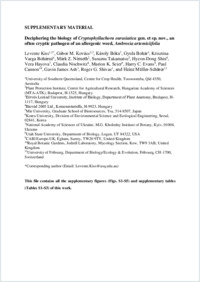Deciphering the biology of Cryptophyllachora eurasiatica gen. et sp. nov., an often cryptic pathogen of an allergenic weed, Ambrosia artemisiifolia
- Kiss, Levente University of Southern Queensland, Centre for Crop Health, Australia - Plant Protection Institute, Centre for Agricultural Research, Hungarian Academy of Sciences, Budapest, Hungary
- Kovács, Gábor M. Plant Protection Institute, Centre for Agricultural Research, Hungarian Academy of Sciences, Budapest, Hungary - Eötvös Loránd University, Institute of Biology, Department of Plant Anatomy, Budapest, Hungary
- Bóka, Károly Eötvös Loránd University, Institute of Biology, Department of Plant Anatomy, Budapest, Hungary
- Bohár, Gyula Biovéd 2005 Ltd., Kemenestaródfa,Hungary
- Bohárné, Krisztina Varga Biovéd 2005 Ltd., Kemenestaródfa,Hungary
- Németh, Márk Z. Plant Protection Institute, Centre for Agricultural Research, Hungarian Academy of Sciences, Budapest, Hungary
- Takamatsu, Susumu Mie University, Graduate School of Bioresources, Tsu, Japan
- Shin, Hyeon-Dong Korea University, Division of Environmental Science and Ecological Engineering, Seoul, Korea
- Hayova, Vera National Academy of Sciences of Ukraine, M.G. Kholodny Institute of Botany, Kyiv, Ukraine
- Nischwitz, Claudia Utah State University, Department of Biology, Logan, USA
- Seier, Marion K. CABI Europe-UK, Egham, Surrey, UK
- Evans, Harry C. CABI Europe-UK, Egham, Surrey, UK
- Cannon, Paul F. Royal Botanic Gardens, Jodrell Laboratory, Mycology Section, Kew, UK
- Ash, Gavin James University of Southern Queensland, Centre for Crop Health, Australia
- Shivas, Roger G. University of Southern Queensland, Centre for Crop Health, Australia
- Müller-Schärer, Heinz Department of Biology/Ecology & Evolution, University of Fribourg, Switzerland
-
17.07.2018
Published in:
- Scientific Reports. - 2018, vol. 8, no. 1, p. 10806
English
A little known, unculturable ascomycete, referred to as Phyllachora ambrosiae, can destroy the inflorescences of Ambrosia artemisiifolia, an invasive agricultural weed and producer of highly allergenic pollen. The fungus often remains undetectable in ragweed populations. This work was conducted to understand its origin and pathogenesis, a prerequisite to consider its potential as a biocontrol agent. The methods used included light and transmission electron microscopy, nrDNA sequencing, phylogenetic analyses, artificial inoculations, and the examination of old herbarium and recent field specimens from Hungary, Korea, Ukraine and USA. The Eurasian and the North American specimens of this fungus were to represent two distinct, although closely related lineages that were only distantly related to other lineages within the Ascomycota. Consequently, we describe a new genus that includes Cryptophyllachora eurasiatica gen. et sp. nov. and C. ambrosiae comb. nov., respectively. The pathogenesis of C. eurasiatica was shown in A. artemisiifolia. No evidence was found for either seed-borne transmission or systemic infection. Two hypotheses were developed to explain the interaction between C. eurasiatica and A. artemisiifolia: (i) as yet undetected seed-borne transmissions and latent, systemic infections; or (ii) alternative hosts.
- Faculty
- Faculté des sciences et de médecine
- Department
- Département de Biologie
- Language
-
- English
- Classification
- Biological sciences
- License
-
License undefined
- Identifiers
-
- RERO DOC 322811
- DOI 10.1038/s41598-018-29102-5
- Persistent URL
- https://folia.unifr.ch/unifr/documents/307414
Other files
Statistics
Document views: 106
File downloads:
- pdf: 156
- Supplementary material: 130

